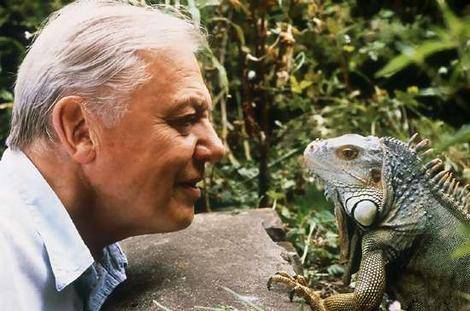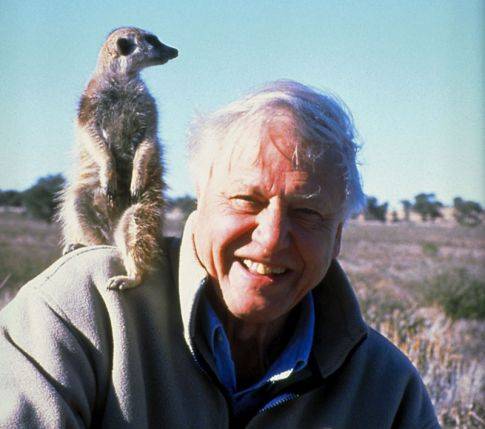Can I please tell you my extra-dorky Friday night secret?
My favorite Friday night activity includes beer and the Planet Earth marathon on Animal Planet. Originally aired in 2007 on Discovery (which owns Animal Planet), Planet Earth is one of the greatest things that has ever been on TV, and the joy I feel when I catch multiple episodes of it knows no bounds. It covers all the ecosystems you could ever hope for (Mountains! Deserts! Jungles!). It includes insanely beautiful and expensive shots of rare plants and animals in their native environments. And while Ripley (Sigourney Weaver) narrates the American version of the show (I’m not sure why), the true earthly authority on all living things, Sir David Attenborough, narrates and wrote the original British version, and he is the man we’re here to talk about today.
 I’ll take the dorkiness a step further. A few years ago, I was so obsessed with everything David Attenborough ever touched, I used to walk my happy self down to the old Champaign Public Library (when it used to look like a nameless, sad pharmaceutical company) almost everyday to check out all of his BBC creations. And I watched them back-to-back-to-back, over and over, for days on end. David Attenborough can give an impassioned, intelligent monologue about any living thing anywhere on this planet. He’s been making nature shows since the ’70s, and he was one of the first participant-hosts, like Jacques Cousteau. In fact, without Attenborough and Cousteau, we wouldn’t have The Crocodile Hunter (R.I.P.) or Jeff Corwin or any of the other daredevil run-around-after-animals-you-shouldn’t-be-running-around-after nature show hosts that populate Animal Planet, PBS, and Discovery these days. Trust me though, Attenborough did it first, best, and most respectfully.
I’ll take the dorkiness a step further. A few years ago, I was so obsessed with everything David Attenborough ever touched, I used to walk my happy self down to the old Champaign Public Library (when it used to look like a nameless, sad pharmaceutical company) almost everyday to check out all of his BBC creations. And I watched them back-to-back-to-back, over and over, for days on end. David Attenborough can give an impassioned, intelligent monologue about any living thing anywhere on this planet. He’s been making nature shows since the ’70s, and he was one of the first participant-hosts, like Jacques Cousteau. In fact, without Attenborough and Cousteau, we wouldn’t have The Crocodile Hunter (R.I.P.) or Jeff Corwin or any of the other daredevil run-around-after-animals-you-shouldn’t-be-running-around-after nature show hosts that populate Animal Planet, PBS, and Discovery these days. Trust me though, Attenborough did it first, best, and most respectfully.
He will stand on the side of a mountain in Scotland whilst hawks swoop down at his head, explaining why a certain grass is the only thing that can live at that altitude. He’ll let fiddler crabs crawl all over him while he describes the fact that they only mate once a year on such-and-such obscure island in the south Pacific because of the moon or something. He will sit up in a tree looking down on a group of komodo dragons ravenously tearing apart a goat he and his producers sacrificed just to get the shot. He will coolly stand a few feet away from a group of chimpanzees eating one of their own. (Did you know this? Chimps are not the cute cuddly friends that toddle along after Clint Eastwood or Michael Jackson, learning sign language and wearing diapers. They’re stone cold cruel creatures that fight to the death over territory — and cannibalize! David Attenborough taught me this.) He will stand on the breeding beach watching elephant seals battle over a mate (warning: clip shows both elephant seal sex and Attenborough running wildly from battling elephant seals). And he does it all without screwing up or breaking his amazing live descriptions of what’s going on in the natural world around us.
My favorite of all the Attenborough shows is The Living Planet. Similar in scope to Planet Earth but lacking HD fanciness because it’s from the ’80s, The Living Planet handles even better ecosystems in weirder ways (Oh dear Lord, I’m such a nerd). It’s a 12-part series, and I know for truth that you can get them all at the Champaign Public Library on VHS. The best episode is “Worlds Apart,” about islands and atolls, and how animals on islands had their own evolution, independent of the evolutions occurring on continents. Did you know that there are flies that only exist on a certain mountain in Hawaii, and one mountain over there are flies that are related to the other flies but completely different? And flightless birds like the dodo evolved on islands like New Zealand because there were no land predators until Europeans brought them? And that said Europeans could walk right up to dodos and club them to death, because the poor stupid birds didn’t know enough to run in the other direction. It’s all such an interesting and weird tragedy, and it exists! David Attenborough showed it to me.
 Other recommended shows include: The Life of Birds (Watch this clip to see what a lyrebird can do … please! There’s also a scene in the series that captures the mating habits of some rare sparrow in England. The female of the species mates with multiple males and, um, expels the ejaculate of the males she deems unworthy — it’s so gross.), The Life of Mammals (chimpanzee cannibals), and Blue Planet: Seas of Life (Attenborough wrote and narrates this one, which is from a few years ago and includes HD fanciness).
Other recommended shows include: The Life of Birds (Watch this clip to see what a lyrebird can do … please! There’s also a scene in the series that captures the mating habits of some rare sparrow in England. The female of the species mates with multiple males and, um, expels the ejaculate of the males she deems unworthy — it’s so gross.), The Life of Mammals (chimpanzee cannibals), and Blue Planet: Seas of Life (Attenborough wrote and narrates this one, which is from a few years ago and includes HD fanciness).
I’ve exposed a lot, but I haven’t gone too far out on a limb here, have I? I mean, nature shows aren’t exactly an acquired taste. Everyone kind of loves them, right? They might remind you of some stifling third-grade classroom you sat in, or of being sick, laying on your couch, watching whatever came on TV. It’s all fascinating, nonetheless.
Plus, it’s really hard to change the channel when a killer whale is eating a cute baby sea lion. That’s nature, man. It happens, like, every single day. Hit up the library to learn about it.








